Search the Special Collections and Archives Portal
Search Results
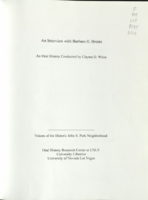
Transcript of interview with Barbara G. Brents Claytee D. White, January 12, 2010
Date
2010-01-12
Archival Collection
Description
When Barbara Brents and her husband Mike moved to Las Vegas in 1987, she had no desire to call it home. It was part of a life adventure, an enchantment with the "Old West" and about a job at UNLV. Sure it wasn't the ivy covered campus, but "the kitsch of Las Vegas was kind of the appeal." Living in John S. Park Neighborhood proved to have a charm on the couple, who have lived in three different homes there. One had a view of Bob Stupak's World of Las Vegas sign and another was used in a scene for the television series Nasty Boys. Their current home was previously owned by Berkeley Bunker, a former U.S. Senator. Over the years they have enticed others to live in John S. Park and continue live there themselves. Barbara shares historic footnotes, political stories, and what lead up to the historic districting of the neighborhood she so dearly cherishes. As she says, "The reason I like Las Vegas is this neighborhood, and I would be gone in a second if this neighborhood died."
Text
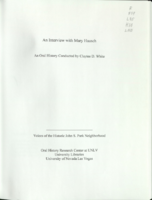
Transcript of interview with Mary Hausch by Claytee D. White, April 7, 2009
Date
2009-04-07
Archival Collection
Description
It was spring vacation 1971 when Mary Hausch arrived in Las Vegas with four girlfriends. As a Ohio University senior, the closing of college campuses due to anti-Vietnam War protests had given her a reprieve from final tests and papers. The spontaneity of the trip and her enjoyment of the weather resulted in her applying for, and getting, a reporter position at the Las Vegas Review-Journal. For the next nineteen years, she worked her way up the newspaper ladder, covered local education issues that included desegregation, a groundbreaking series of POW-MIA war stories, and the Nevada legislature. She became the first woman city editor and managing editor of the newspaper. Her career journey was not always smooth. It was an era of cultural roadblocks and emerging feminism. Eventually, Mary was passed over for the ultimate appointment of R-J editor and was placated with a short-lived "associate editor" position. She describes the ensuing civil rights complaints and how she segued into teaching at UNLV. During her robust journalism career, Mary's personal life also hit some rocky times, but ended happily when she met and married Bob Coffin, a then reporter for the newspaper. [Bob is interviewed separately for this John S. Park neighborhood series.] The couple bought the Gubler House in John S. Park and Mary describes the charm of the house as well as the neighborhood, historically and currently. Mary was a tireless participant in the efforts to have John S. Park designated a historic neighborhood. This two-part interview paints a picture of a community that has weathered various phases from what she calls the "widow phase" to the "homeless" to the rebirth stirred by new residents. She also offers advice and thoughts for those looking to achieve the historic designation for their neighborhood.
Text
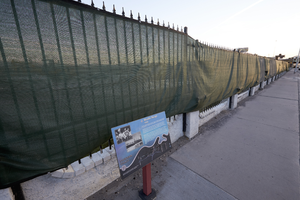
Moulin Rouge site, Las Vegas, Nevada: digital photograph
Date
2016-10-18
Archival Collection
Description
The remnants of buildings that once surrounded the famed Moulin Rouge hotel and casino in the historic Westside neighborhood. The buildings were schedule to be demolished shortly after these images were taken. Years of neglect and fires claimed the original building.
Image

Brochure, Pioneer Trail of West Las Vegas community
Date
2006
Archival Collection
Description
Brochure highlights and maps historic points of interest in West Las Vegas.
Text
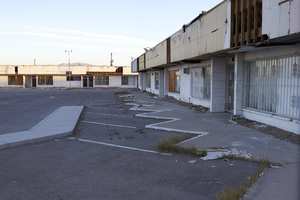
Moulin Rouge site, Las Vegas, Nevada: digital photograph
Date
2016-10-18
Archival Collection
Description
The remnants of buildings that once surrounded the famed Moulin Rouge hotel and casino in the historic Westside neighborhood. The buildings were schedule to be demolished shortly after these images were taken. Years of neglect and fires claimed the original building.
Image
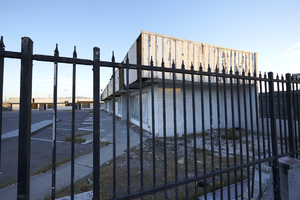
Moulin Rouge site, Las Vegas, Nevada: digital photograph
Date
2016-10-18
Archival Collection
Description
The remnants of buildings that once surrounded the famed Moulin Rouge hotel and casino in the historic Westside neighborhood. The buildings were schedule to be demolished shortly after these images were taken. Years of neglect and fires claimed the original building.
Image

Moulin Rouge site, Las Vegas, Nevada: digital photograph
Date
2016-10-18
Archival Collection
Description
The remnants of buildings that once surrounded the famed Moulin Rouge hotel and casino in the historic Westside neighborhood. The buildings were schedule to be demolished shortly after these images were taken. Years of neglect and fires claimed the original building.
Image
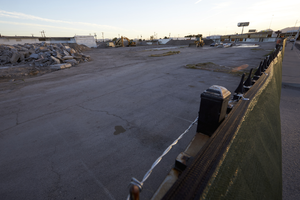
Moulin Rouge site, Las Vegas, Nevada: digital photograph
Date
2016-10-18
Archival Collection
Description
The remnants of buildings that once surrounded the famed Moulin Rouge hotel and casino in the historic Westside neighborhood. The buildings were schedule to be demolished shortly after these images were taken. Years of neglect and fires claimed the original building.
Image
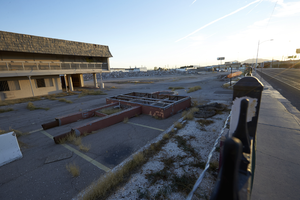
Moulin Rouge site, Las Vegas, Nevada: digital photograph
Date
2016-10-18
Archival Collection
Description
The remnants of buildings that once surrounded the famed Moulin Rouge hotel and casino in the historic Westside neighborhood. The buildings were schedule to be demolished shortly after these images were taken. Years of neglect and fires claimed the original building.
Image
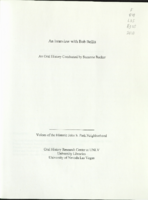
Transcript of interview with Bob Bellis by Suzanne Becker, June 19, 2007
Date
2007-06-19
Archival Collection
Description
Starting at a young age, Bob Bellis' parents instilled upon him the importance of being a good neighbor and a community advocate. He was raised in Pahrump and moved to Las Vegas circa 1984. A few years later, he was living in the John S. Park neighborhood where his deeply rooted tradition of community found a purpose—preserve a historic area of Las Vegas. He enumerates the downside of living in John S. Park, but quickly adds reasons for remaining as the neighborhood reinvents itself for the next generation. Bob has not been an idle resident and headed up the creation of the John S. Park Neighborhood Association starting in 2000. Bob touches upon the history of the community and its evolution to a more diverse profile. Yes, two homeless people were living in the backyard when he moved in, but John S. Park is not a crime-riddled place to live he explains. The more looming threat of high-rises is an issue that concerns him.
Text
Pagination
Refine my results
Content Type
Creator or Contributor
Subject
Archival Collection
Digital Project
Resource Type
Year
Material Type
Place
Language
Records Classification
